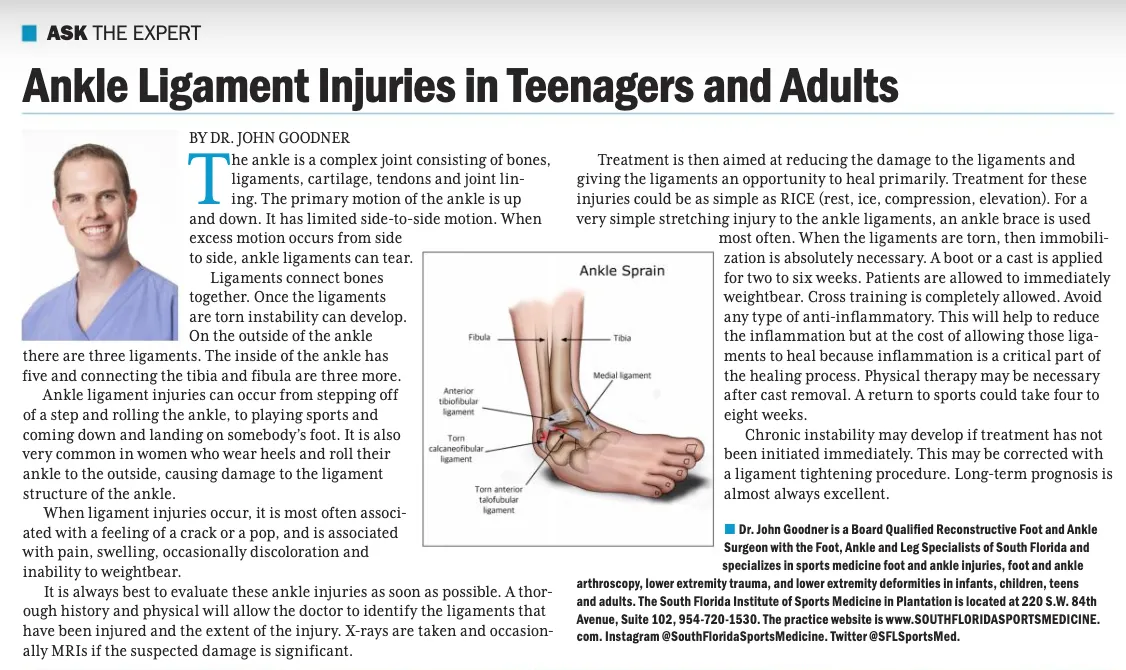
ANKLE LIGAMENT INJURIES IN CHILDREN
Robert H. Sheinberg, D.P.M., D.A.B.F.A.S., F.A.C.F.A.S.
Ligament injuries to the ankle are more common in children than previously thought. The ligaments connect bones together. When the ligament stretches beyond its elastic limit, partial or complete tears develop. The most common ligament injury in the ankle is due to a twisting injury of the foot down and in. This can occur from sports, twisting the foot under the leg in a hole or even falling off of a shoe. These injuries may be associated with mild growth plate injuries. Usually the ligament injury or the growth plate is the more dominant problem. A thorough evaluation will best determine the injured part and the extent of it.
Because the ligaments in the ankle connect below the growth plate it was more commonly thought that growth plates are weaker than ligaments and when twisting occurs the growth plate usually gets injured. With the increased participation in sports at a very young age the frequency of ankle ligament injuries has been rising.
Signs and Symptoms:
- Low-grade to diffuse swelling present along the front part of the outer ankle.
- Swelling may be present on the inner ankle in severe outer ankle sprains. It may also be present with an inner ankle sprain where the foot turns down and in.
- Immediate difficulty weightbearing.
- Discoloration to the ankle and foot may develop a few days later.
Evaluation:
- Immediate evaluation is necessary to determine the extent of injury. The foot, ankle and leg are examined to determine which ligament is injured and the degree of injury associated with it. Testing of the ligament’s integrity is also performed to further assess the damage.
- Examination of the growth plates, tendons and bones around the ankle are also performed to determine any associated injuries.
X-rays:
- X-rays are necessary to determine if there are any associated bone injuries. Growth plates are evaluated to see if they are out of position.
MRIs:
- MRIs are rarely necessary as a good clinical exam usually provides all the necessary information in formulating a diagnosis and treatment plan. An MRI is done only if there is suspicion of a cartilage injury that cannot be assessed via a clinical examination or x-ray.
Treatment:
- Immediate care is necessary to prevent any long-term problems.
- Mild injuries associated with minimal swelling may be treated with rest, ice, elevation and an ankle brace.
- Moderate injuries in which a partial tear has occurred may necessitate immobilization for 2-6 weeks in a removable boot or hard cast.
- Severe injuries need to be immobilized in a hard fiberglass cast for 4-6 weeks to allow the ligaments to heal properly.
- Physical therapy following bracing or cast removal is necessary to improve muscle strength, ankle stability, joint proprioception and to restore complete ankle motion.
- If left untreated, chronic instability commonly develops. Recurring twisting injuries then occur with minimal stress. This will require chronic use of an ankle brace and physical therapy. In most cases surgery would be necessary to surgically reconstruct the ligaments in the ankle and allow a full return to activity.


